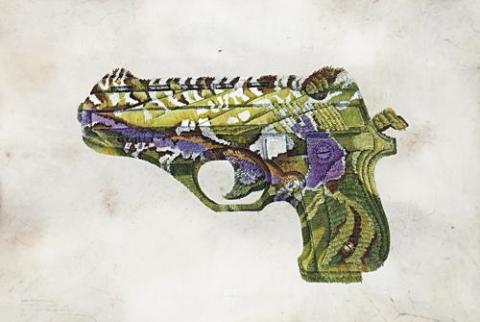GODLESS, 2002
Ex De Medici
watercolour and gouache on vellum
56.5 x 85.0 cm
Helen Maxwell Gallery, Canberra
CARPart collection, Canberra
In the Presence of Passion, Helen Maxwell Gallery, Canberra, 20 September – 19 October 2003, cat. 11
eX de Medici @ MPRG, Mornington Peninsular Regional Gallery, Victoria, 10 April – 23 May 2004
With her vast and varied oeuvre incorporating experimental performance, installation, photography, painting, drawing and tattooing, eX de Medici has earned a reputation as one of the most brilliant enigmas of the Australian art world. In 2001, she was commissioned by the National Portrait Gallery, Canberra to create a portrait of rock band Midnight Oil, and the following year, was awarded the Mornington Peninsula Regional Gallery's prestigious 'National Works on Paper Prize' for her large and complex watercolour, Red (Colony), 1999-2000. Her work has featured in solo exhibitions such as Soft Steel at Heide Museum of Modern Art, Melbourne (2003) and eX de Medici at Mornington Peninsula Regional Gallery (2004), as well as numerous group shows, including the recent Contemporary Commonwealth at the National Gallery of Victoria, Melbourne (2006).
Since the late 1990s in particular, de Medici has become widely acclaimed for her monumental, fastidiously executed watercolours and drawings such as Godless, 2002, which juxtapose emblems of power and oppression with motifs encapsulating the fragility of life. Paying homage to the traditions of both natural history illustration associated with the scientific classification of the world (specifically, the exquisite taxonomic drawings of Ferdinand Bauer in the collection of the National Gallery of Australia, Canberra) and seventeenth-century Dutch vanitas painting, indeed her works may be interpreted as contemporary momento mori, reminding us of our mortality and the futility of worldly pursuits.
Recurring motifs such as skulls, ammunition and the historically-loaded emblem of the swastika elucidate more explicitly de Medici's often controversial denunciation of the troubling currents of our times " from the fascist tendencies which she perceived in the policies of the Howard government and the ideology of Pauline Hanson's One Nation, to universal issues of power and control powerfully symbolised by the gun in the present work. As the artist observes; '...the gun is meant for one thing and one thing only. They afford people a sense of invulnerability, but in the end the State employs guns to do the final work. So the gun, in my work, is always about controlling something, about the final word.'1 Thus, with their painstaking detail and seductive, visceral quality, de Medici's compositions invite the viewer to contemplate a world where pleasant, alluring surfaces conceal - and paradoxically reveal - disturbing intentions and forces from the past.
1. Ex-De Medici cited in Boyd, C., 'The order beneath the skin', The Weekend Australian Financial Review, 17-18 April 2004, p. 32
VERONICA ANGELATOS
